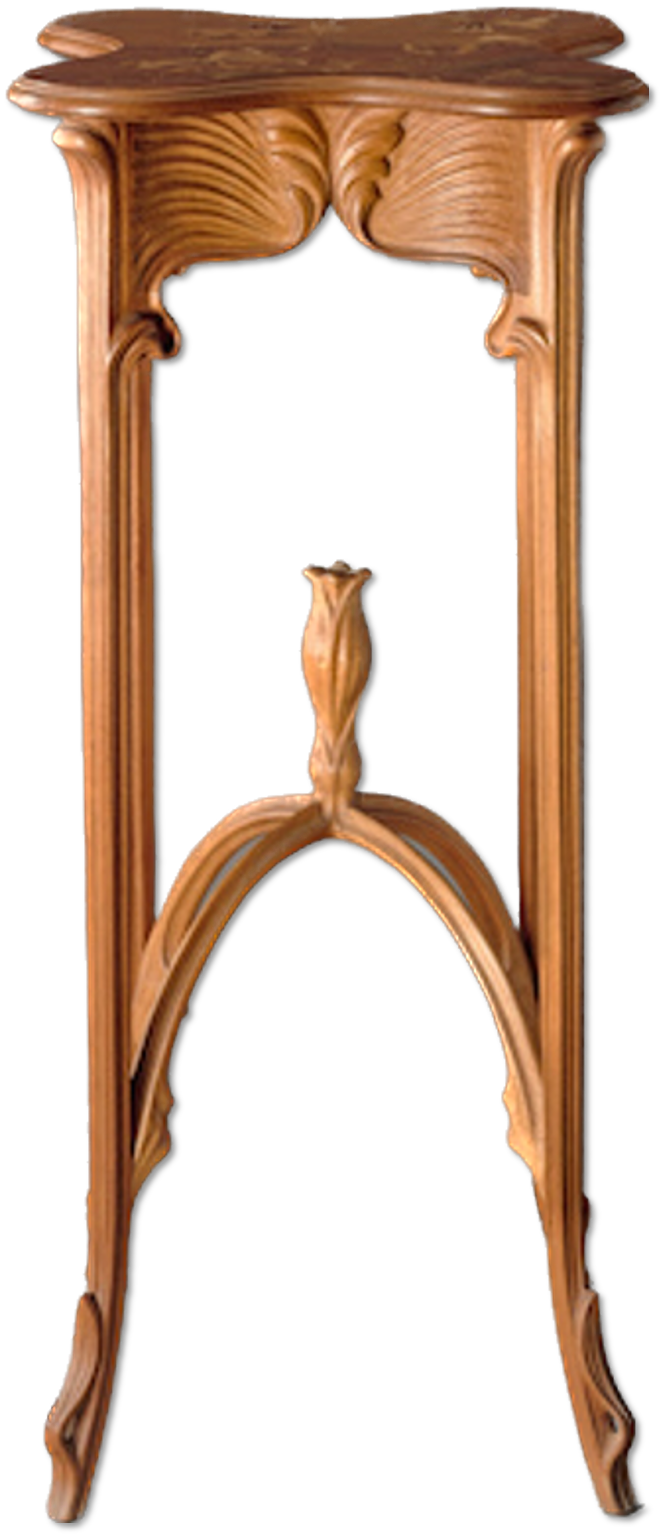Gallé's Exotic Wood Carving
Gallé’s intricate wood carving in several of the wooden furniture pieces he exhibited at the 1900 exposition incorporated themes that recall products of colonialism. In carving these elaborate designs out of wood, Gallé borrowed the ideology of France’s civilizing mission. He took raw, “untamed” materials from French colonies and shaped them into a refined, finished product. For example, Gallé’s Africa bookcase (ca. 1900, Figure 26), whose material the artist described as “tropical hardwood” in his 1900 pamphlet, is anchored by a strong, rectangular base, with carved curvilinear ornamentation that disrupts the blocky quality of the piece. The surface of the piece is incredibly detailed and impeccably crafted. High relief and openwork wood carvings emerge from the flat surface of the wood on all visible sides, decorating the bookshelf to look like it captures a frozen moment of time in nature. It is studded with a variety of small sculptural animals carved from the same wood– frogs, snails, and butterflies. [1] Vegetation carved in openwork in the front panel curls around the bottom panel of the door, flowers and leaves intermingling with a butterfly whose carved wings almost seem to lift off the surface. A stalky plant of some kind extends upwards, with sharp, arrow-like leaves that turn in at the edge giving the appearance that they are dry and in need of rain. A flower crowns the top of the plant, its petals curling over on themselves.
The carved ornamentations call attention to the surface of the wood, a rich, chocolate-hued wood with vertical striations and tonal variations. Though the wood species was not identified by Gallé, the distinctive striped quality of the wood suggests that this could be tigerwood (Figure 27), a variety of wood indigenous to Africa, and fitting with the title of the work. The African continent served as the main source of exotic wood in France, with nearly 65 percent coming from Afrique Occidentale Française (French West Africa).[2] The use of this exotic bois des îles helps to elevate the status of this piece even more. This wood is also extremely dense, proving a difficult challenge for any woodworker to carve.[3] The fact that Gallé has executed so many individual elements and in such detail speaks to his skill as an artist, and as a woodworker.
Figure 26: Émile Gallé, Africa Bookcase, ca. 1900. Tropical hardwood. From Alastair Duncan and Georges de Bartha, Gallé Furniture (Suffolk: Antique Collectors’ Club: 2012), 71.
Figure 28: Émile Gallé, Bananier Sellette, 1900. Cashew wood, marquetry in various woods. 105 x 48 x 48 cm. Musée d’Orsay, Paris.
Gallé again showed his expert ability of refinement of raw materials in his small table, Bananier Sellette (Banana Tree Small Table, 1900, Figure 28). The table is named for the banana tree, whose fruit was not grown domestically in France at that time. Rather, bananas and other tropical fruits were imported from French colonies in North Africa, West Africa, and the Caribbean.[4] The table is a clear instance of Gallé drawing inspiration from nature, and in this case, he applied the characteristics of a banana tree to the construction of the piece. The base of the table displays carved, streamlined edges and simplified forms, all alluding to the banana tree. The sellette’s legs are typically thin and delicate, with undulating strips at the bottoms of the legs that playfully evoke the form of a banana peel, half removed from the fruit. If carved from a single piece of wood, the immense precision and skill required to execute such a design are evident in the negative space between the “peel” and the “fruit” of the leg. The legs travel up in Gallé’s signature vine style, portions of each one branching off to meet one another in the center. A flower, carved from one solid piece of wood, grows up from the center, closely resembling a banana blossom (Figure 29-30). Each sculpted leg terminates into a rounded banana leaf, supporting the tabletop. Gallé’s choice to use cashew wood, a bois des îles grown in the Caribbean, Africa, and South America, and to leave it untreated allows for the whole table to take on the golden hue of a ripe banana peel. The entire table is evocative not only of the tropical fruit, but of the trade happening between France and French colonies that allowed Gallé access to both the fruit that inspired the table and the wood it was made from. By choosing to carve with excruciating detail a table inspired by the banana, Gallé placed colonialism as central to his work as a fine artist, once again employing France’s civilizing mission in his own artwork.
[1]. Duncan and de Bartha, Gallé Furniture, 56; I have not been able to track down an original version of the document, so I reference the version reproduced here.
[2]. Ministère des Colonies, Nos Richesses d’outre-mer: Commerce et navigation), 100.
[3]. “The Pros and Cons of Tigerwood Flooring and Tigerwood Decking,” Wagner Meters.
[4]. Robert Aldrich, Greater France: A History of French Overseas Expansion. (New York: St. Martin’s Press, 1996), 165.




